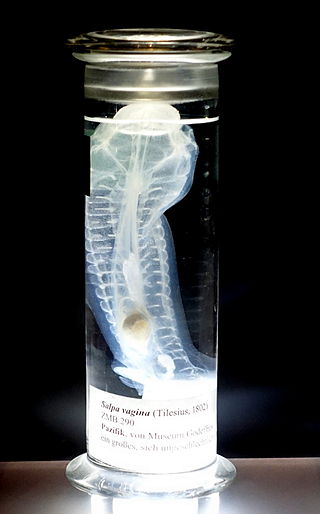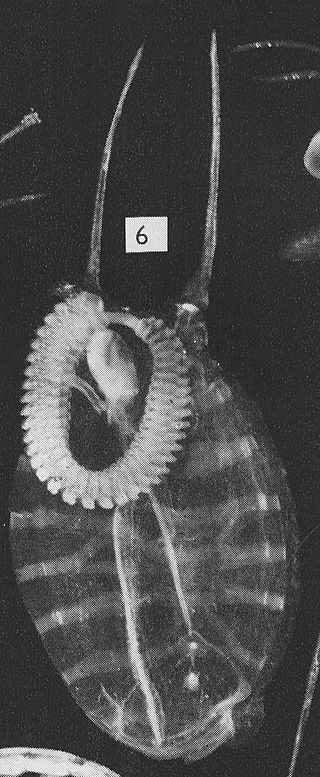
Thaliacea is a class of marine chordates within the subphylum Tunicata, comprising the salps, pyrosomes and doliolids. Unlike their benthic relatives the ascidians, from which they are believed to have emerged, thaliaceans are free-floating (pelagic) for their entire lifespan. The group includes species with complex life cycles, with both solitary and colonial forms.

A salp or salpa is a barrel-shaped, planktonic tunicate in the family Salpidae. It moves by contracting, thereby pumping water through its gelatinous body; it is one of the most efficient examples of jet propulsion in the animal kingdom. The salp strains the pumped water through its internal feeding filters, feeding on phytoplankton.
Cyclosalpa bakeri is a salp, a marine tunicate in the class Thaliacea. It is found floating in the open sea in the Indo-Pacific region.

The largest animal currently alive is the blue whale. The maximum recorded weight was 190 tonnes for a specimen measuring 27.6 metres (91 ft), whereas longer ones, up to 33 metres (108 ft), have been recorded but not weighed. It is estimated that this individual could have a mass of 250 tonnes or more. The longest non-colonial animal is the lion's mane jellyfish.

Thetys vagina, or the twin-sailed salp, is the largest known solitary species of salp and the only valid species of the genus Thetys. First described by W.G Tilesius in 1802, the species is transparent and gelatinous, making it difficult to be seen in water, which is helpful in avoiding predators. The fossil range is very recent. Other animals often mistaken for T. vagina are Salpa fusiformis, Aurelia aurita, and Pegea confoederata. There is no known status of conservation in this species. T. vagina DNA was sequenced as part of a larger project in 2014 where spiny lobster larvae were found attached to T. vagina and consuming it.

Myrtle Elizabeth Johnson was an American marine biologist, ascidiologist, and educator in California in the early 20th century. She was the first woman PhD faculty member at the San Diego State College, where she taught from 1921 to 1946, and was chair of the Biology department from 1928 to 1940. Her major work, Seashore Animals of the Pacific Coast, published in 1927, was the standard descriptive text of intertidal species until Ed Ricketts's Between Pacific Tides was published in 1939. Ricketts considered Johnson's book "the vade mecum of marine biologists of the Pacific. Indispensable."
Clavelina minuta is a species of sea squirt found in Japan, that has been demonstrated to produce an intrinsic (non-secreted) green bioluminescence of 535 nm. Notably, this bioluminescence is not thought to be due to bacterial symbionts. Clavelina minuta is currently the only sea squirt (Ascidiacea) known to produce light, however old reports also report luminescence in Botryllus and Ciona. Amongst other tunicates, the unrelated Pyrosoma and Appendicularia, which produce an intrinsic blue light, are bioluminescent, and genera Doliolum (Doliolidae) and Cyclosalpa (Salpidae) may also be bioluminescent.

Thalia is a genus of tunicates belonging to the family Salpidae.





